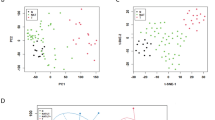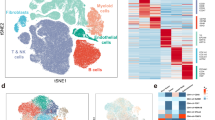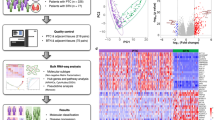Abstract
The purpose of this paper is to correlate the molecular phenotype of papillary thyroid carcinoma (PTC) to their biological pathology. We hybridized 26 PTC on microarrays and showed that nearly 44% of the transcriptome was regulated in these tumors. We then combined our data set with two published PTC microarray studies to produce a platform- and study-independent list of PTC-associated genes. We further confirmed the mRNA regulation of 15 genes from this list by quantitative reverse transcription–PCR. Analysis of this list with statistical tools led to several conclusions: (1) there is a change in cell population with an increased expression of genes involved in the immune response, reflecting lymphocyte infiltration in the tumor compared to the normal tissue. (2) The c-jun N-terminal kinase pathway is activated by overexpression of its components. (3) The activation of ERKK1/2 by genetic alterations is supplemented by activation of the epidermal growth factor but not of the insulin-like growth factor signaling pathway. (4) There is a downregulation of immediate early genes. (5) We observed an overexpression of many proteases in accordance with tumor remodeling, and suggested a probable role of S100 proteins and annexin A2 in this process. (6) Numerous overexpressed genes favor the hypothesis of a collective migration mode of tumor cells.
This is a preview of subscription content, access via your institution
Access options
Subscribe to this journal
Receive 50 print issues and online access
$259.00 per year
only $5.18 per issue
Buy this article
- Purchase on Springer Link
- Instant access to full article PDF
Prices may be subject to local taxes which are calculated during checkout





Similar content being viewed by others
Accession codes
References
Alberti L, Carniti C, Miranda C, Roccato E, Pierotti MA . (2003). RET and NTRK1 proto-oncogenes in human diseases. J Cell Physiol 195: 168–186.
Baris O, Mirebeau-Prunier D, Savagner F, Rodien P, Ballester B, Loriod B et al. (2005). Gene profiling reveals specific oncogenic mechanisms and signaling pathways in oncocytic and papillary thyroid carcinoma. Oncogene 24: 4155–4161.
Borrello MG, Alberti L, Fischer A, Degl'innocenti D, Ferrario C, Gariboldi M et al. (2005). Induction of a proinflammatory program in normal human thyrocytes by the RET/PTC1 oncogene. Proc Natl Acad Sci USA 102: 14825–14830.
Ciampi R, Nikiforov YE . (2005). Alterations of the BRAF gene in thyroid tumors. Endocr Pathol 16: 163–172.
Dano K, Behrendt N, Hoyer-Hansen G, Johnsen M, Lund LR, Ploug M et al. (2005). Plasminogen activation and cancer. Thromb Haemost 93: 676–681.
de Visser KE, Eichten A, Coussens LM . (2006). Paradoxical roles of the immune system during cancer development. Nat Rev Cancer 6: 24–37.
Dennis Jr G, Sherman BT, Hosack DA, Yang J, Gao W, Lane HC et al. (2003). DAVID: database for annotation, visualization, and integrated discovery. Genome Biol 4: 3.
Detours V, Wattel S, Venet D, Hutsebaut N, Bogdanova T, Tronko MD et al. (2005). Absence of a specific radiation signature in post-Chernobyl thyroid cancers. Br J Cancer 92: 1545–1552.
Farooq A, Zhou MM . (2004). Structure and regulation of MAPK phosphatases. Cell Signal 16: 769–779.
Fiddes RJ, Campbell DH, Janes PW, Sivertsen SP, Sasaki H, Wallasch C et al. (1998). Analysis of Grb7 recruitment by heregulin-activated erbB receptors reveals a novel target selectivity for erbB3. J Biol Chem 273: 7717–7724.
Fluge O, Akslen LA, Haugen DR, Varhaug JE, Lillehaug JR . (2000). Expression of heregulins and associations with the ErbB family of tyrosine kinase receptors in papillary thyroid carcinomas. Int J Cancer 87: 763–770.
Fluge O, Bruland O, Akslen LA, Lillehaug JR, Varhaug JE . (2006). Gene expression in poorly differentiated papillary thyroid carcinomas. Thyroid 16: 161–175.
Friedl P . (2004). Prespecification and plasticity: shifting mechanisms of cell migration. Curr Opin Cell Biol 16: 14–23.
Gimm O . (2001). Thyroid cancer. Cancer Lett 163: 143–156.
Giordano TJ, Kuick R, Thomas DG, Misek DE, Vinco M, Sanders D et al. (2005). Molecular classification of papillary thyroid carcinoma: distinct BRAF, RAS, and RET/PTC mutation-specific gene expression profiles discovered by DNA microarray analysis. Oncogene 24: 6646–6656.
Haugen DR, Akslen LA, Varhaug JE, Lillehaug JR . (1996). Expression of c-erbB-3 and c-erbB-4 proteins in papillary thyroid carcinomas. Cancer Res 56: 1184–1188.
Hawthorn L, Stein L, Varma R, Wiseman S, Loree T, Tan D . (2004). TIMP1 and SERPIN-A overexpression and TFF3 and CRABP1 underexpression as biomarkers for papillary thyroid carcinoma. Head Neck 26: 1069–1083.
Hoelting T, Siperstein AE, Clark OH, Duh QY . (1994). Epidermal growth factor enhances proliferation, migration, and invasion of follicular and papillary thyroid cancer in vitro and in vivo. J Clin Endocrinol Metab 79: 401–408.
Hosack DA, Dennis Jr G, Sherman BT, Lane HC, Lempicki RA . (2003). Identifying biological themes within lists of genes with EASE. Genome Biol 4: R70.1–R70.8.
Huang Y, Prasad M, Lemon WJ, Hampel H, Wright FA, Kornacker K et al. (2001). Gene expression in papillary thyroid carcinoma reveals highly consistent profiles. Proc Natl Acad Sci USA 98: 15044–15049.
Jarzab B, Wiench M, Fujarewicz K, Simek K, Jarzab M, Oczko-Wojciechowska M et al. (2005). Gene expression profile of papillary thyroid cancer: sources of variability and diagnostic implications. Cancer Res 65: 1587–1597.
Kondo T, Ezzat S, Asa SL . (2006). Pathogenetic mechanisms in thyroid follicular-cell neoplasia. Nat Rev Cancer 6: 292–306.
Kurten RC, Cadena DL, Gill GN . (1996). Enhanced degradation of EGF receptors by a sorting nexin, SNX1. Science 272: 1008–1010.
Lanzetti L, Rybin V, Malabarba MG, Christoforidis S, Scita G, Zerial M et al. (2000). The Eps8 protein coordinates EGF receptor signalling through Rac and trafficking through Rab5. Nature 408: 374–377.
Livolsi VA, Albores-Saavedra J, Asa Sl, Baloch ZW, Baloch ZW, Baloch ZW et al. (2004). Pathology and Genetics of Tumours of Endocrine Organs. In: DeLellis RA, LLoyd RV, Heitz PU, Eng Ch (eds). Oxford University press: Oxford, pp 57–66.
Mandl M, Slack DN, Keyse SM . (2005). Specific inactivation and nuclear anchoring of extracellular signal-regulated kinase 2 by the inducible dual-specificity protein phosphatase DUSP5. Mol Cell Biol 25: 1830–1845.
Melillo RM, Castellone MD, Guarino V, De Falco V, Cirafici AM, Salvatore G et al. (2005). The RET/PTC-RAS-BRAF linear signaling cascade mediates the motile and mitogenic phenotype of thyroid cancer cells. J Clin Invest 115: 1068–1081.
Milde-Langosch K . (2005). The Fos family of transcription factors and their role in tumourigenesis. Eur J Cancer 41: 2449–2461.
Mitsiades CS, Kotoula V, Poulaki V, Sozopoulos E, Negri J, Charalambous E et al. (2006). Epidermal growth factor receptor as a therapeutic target in human thyroid carcinoma: mutational and functional analysis. J Clin Endocrinol Metab 91: 3662–3666.
Normanno N, De Luca A, Bianco C, Strizzi L, Mancino M, Maiello MR et al. (2006). Epidermal growth factor receptor (EGFR) signaling in cancer. Gene 366: 2–16.
Pavlidis P, Li Q, Noble WS . (2003). The effect of replication on gene expression microarray experiments. Bioinformatics 19: 1620–1627.
Powell Jr DJ, Eisenlohr LC, Rothstein JL . (2003). A thyroid tumor-specific antigen formed by the fusion of two self proteins. J Immunol 170: 861–869.
Prasad ML, Pellegata NS, Huang Y, Nagaraja HN, de la CA, Kloos RT . (2005). Galectin-3, fibronectin-1, CITED-1, HBME1 and cytokeratin-19 immunohistochemistry is useful for the differential diagnosis of thyroid tumors. Mod Pathol 18: 48–57.
Semov A, Moreno MJ, Onichtchenko A, Abulrob A, Ball M, Ekiel I et al. (2005). Metastasis-associated protein S100A4 induces angiogenesis through interaction with annexin II and accelerated plasmin formation. J Biol Chem 280: 20833–20841.
Shin E, Hong SW, Kim SH, Yang WI . (2004). Expression of down stream molecules of RET (p-ERK, p-p38 MAPK, p-JNK and p-AKT) in papillary thyroid carcinomas. Yonsei Med J 45: 306–313.
Sid B, Dedieu S, Delorme N, Sartelet H, Rath GM, Bellon G et al. (2006). Human thyroid carcinoma cell invasion is controlled by the low density lipoprotein receptor-related protein-mediated clearance of urokinase plasminogen activator. Int J Biochem Cell Biol 38: 1729–1740.
Skrzydlewska E, Sulkowska M, Koda M, Sulkowski S . (2005). Proteolytic–antiproteolytic balance and its regulation in carcinogenesis. World J Gastroenterol 11: 1251–1266.
Subramanian A, Tamayo P, Mootha VK, Mukherjee S, Ebert BL, Gillette MA et al. (2005). Gene set enrichment analysis: a knowledge-based approach for interpreting genome-wide expression profiles. Proc Natl Acad Sci USA 102: 15545–15550.
Vandesompele J, De Preter K, Pattyn F, Poppe B, Van Roy N, De Paepe A et al. (2002). Accurate normalization of real-time quantitative RT-PCR data by geometric averaging of multiple internal control genes. Genome Biol 3: RESEARCH0034.01–0034.112.
Vasko V, Espinosa AV, Scouten W, He H, Auer H, Liyanarachchi S et al. (2007). Gene expression and functional evidence of epithelial-to-mesenchymal transition in papillary thyroid carcinoma invasion. Proc Natl Acad Sci USA 104: 2803–2808.
Wattel S, Mircescu H, Venet D, Burniat A, Franc B, Frank S et al. (2005). Gene expression in thyroid autonomous adenomas provides insight into their physiopathology. Oncogene 24: 6902–6916.
Zou M, Al Baradie RS, Al Hindi H, Farid NR, Shi Y . (2005). S100A4 (Mts1) gene overexpression is associated with invasion and metastasis of papillary thyroid carcinoma. Br J Cancer 93: 1277–1284.
Acknowledgements
We thank Chantal Degraef for her excellent technical assistance. We acknowledge the confirmation of diagnosis provided by the International Pathology Panel of the Chernobyl Tissue Bank: Dr Alexandr Abrosimov, Professor Masahiro Ito, Professor Virginia LiVolsi, Professor Juan Rosai and Professor Sir Dillwyn Williams. This work was supported by Ministère de la Politique Scientifique (PAI), Action Concertée de la Communauté Française, Fonds National de la Recherche Scientifique, Fonds de la Recherche Scientifique Médicale, Télévie and Fondation Van Buuren. Laurent Delys is supported by Télévie, Vincent Detours by European Union's Marie Curie grant MEIF-CT-2003-501459, Frédérick Libert by the Fonds National de la Recherche Scientifique. The works of all authors were not cited in this paper due to a limitation of space. We apologize for it. Microarray data accession number:GSE3950 (GEO database, NCBI).
Author information
Authors and Affiliations
Corresponding authors
Additional information
Supplementary Information accompanies the paper on the Oncogene website (http://www.nature.com/onc).
Rights and permissions
About this article
Cite this article
Delys, L., Detours, V., Franc, B. et al. Gene expression and the biological phenotype of papillary thyroid carcinomas. Oncogene 26, 7894–7903 (2007). https://doi.org/10.1038/sj.onc.1210588
Received:
Revised:
Accepted:
Published:
Issue Date:
DOI: https://doi.org/10.1038/sj.onc.1210588
Keywords
This article is cited by
-
Functional analysis of a novel, thyroglobulin-embedded microRNA gene deregulated in papillary thyroid carcinoma
Scientific Reports (2017)
-
Collective cell migration of thyroid carcinoma cells: a beneficial ability to override unfavourable substrates
Cellular Oncology (2017)
-
Revisiting the transcriptional analysis of primary tumours and associated nodal metastases with enhanced biological and statistical controls: application to thyroid cancer
British Journal of Cancer (2015)
-
Towards a systemic paradigm in carcinogenesis: linking epigenetics and genetics
Molecular Biology Reports (2015)
-
Anterior gradient protein 2 promotes survival, migration and invasion of papillary thyroid carcinoma cells
Molecular Cancer (2014)



